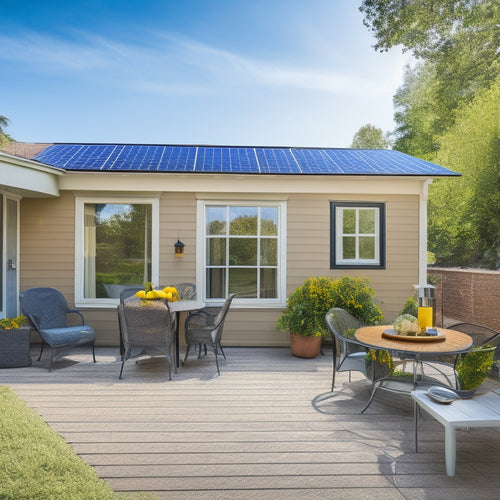
Lower Your Bills With Renewable Energy Systems
Share
By investing in renewable energy systems, you can slash your energy bills by up to 50% and reduce your reliance on non-renewable energy sources, all while minimizing your carbon footprint. Various incentives, such as tax credits and rebates, can offset the upfront costs of shifting to renewable energy. You can optimize your energy storage system design, reduce energy loss, and increase efficiency. From solar power to geothermal heat pumps, biomass energy, and hydroelectric power, there are multiple options to explore. As you explore each option, you'll uncover more ways to reduce your energy expenses and find the best fit for your unique situation.
Key Takeaways
• Solar power and wind energy systems can reduce energy bills by generating electricity on-site and minimizing reliance on non-renewable energy sources.
• Renewable energy systems, such as geothermal and biomass energy, offer cost-effective alternatives to fossil fuels, slashing energy expenditure by up to 50%.
• Hydroelectric power plants can cut electricity costs by up to 30% by harnessing the energy of moving water to generate electricity.
• Incentives like tax credits, grants, and rebates offered by governments and utilities can substantially offset the upfront costs of installing renewable energy systems.
• Optimizing energy storage system design and selecting high-efficiency components can minimize energy losses, further reducing energy bills.
Harnessing Solar Power Savings
You can reduce your reliance on non-renewable energy sources by leveraging solar power to generate electricity, and tapping into substantial savings in the process.
By installing solar panels, you'll not only minimize your carbon footprint but also enjoy considerable cost savings.
The benefits of solar power extend beyond environmental advantages, as you'll also reap financial rewards through Solar Incentives.
These incentives, offered by governments and utilities, can substantially offset the initial investment in your solar system.
To maximize your savings, maximizing energy efficiency is crucial.
Energy Monitoring systems allow you to track your energy usage in real-time, identifying areas for improvement and optimizing your energy efficiency.
By combining solar power with energy monitoring, you'll be able to pinpoint opportunities to reduce your energy consumption, further slashing your energy bills.
With solar power, you'll be harnessing the sun's energy to power your home, and your wallet will thank you.
Wind Energy Cost Reduction
Wind turbines can substantially reduce energy costs by capturing the kinetic energy in wind and converting it into electricity, making it an attractive alternative to fossil fuels. As you consider investing in wind energy, you'll want to know how much you can save. The cost of wind turbines has decreased dramatically over the years, making it a more viable option for homeowners and businesses alike.
Here's a breakdown of the costs and benefits:
| Cost/Benefit | Wind Energy |
|---|---|
| Initial Cost | $2,000 - $10,000 |
| Annual Savings | $400 - $1,000 |
| Payback Period | 5 - 10 years |
Geothermal Heat Pumps Efficiency
As you move away from relying on fossil fuels, geothermal heat pumps emerge as a highly efficient alternative, capable of providing up to four units of energy for every unit of electricity used.
This remarkable efficiency is attributed to the consistent ground temperature, which remains relatively constant throughout the year, allowing the heat pump to operate at peak levels.
To maximize the efficiency of your geothermal heat pump system, consider the following:
-
Proper pipe insulation: Verify that the underground pipes are well-insulated to minimize heat loss and maximize energy transfer.
-
Ground temperature monitoring: Regularly monitor the ground temperature to adjust the system's performance and maximize energy output.
-
System sizing: Correctly size your system to match your energy demands, guaranteeing that you're not wasting energy or compromising efficiency.
- Regular maintenance: Perform routine maintenance checks to confirm the system operates at peak performance and extends its lifespan.
Biomass Energy Cost Benefits
Biomass energy, derived from organic matter, offers a cost-effective alternative to fossil fuels, with the potential to reduce your energy expenditure by up to 50%. By switching to biomass energy, you can substantially lower your energy bills while also contributing to a cleaner environment.
| Energy Source | Carbon Emissions | Cost per kWh |
| Fossil Fuels | High | High |
| Biomass Energy | Low | Low |
| Renewable Energy | Zero | Medium |
| Geothermal Energy | Zero | High |
| Solar Energy | Zero | Medium |
As you can see from the table above, biomass energy offers a low-cost and low-carbon emission alternative to traditional fossil fuels. By diversifying your fuel sources to include biomass energy, you can achieve carbon neutrality and reduce your reliance on fossil fuels. This not only benefits the environment but also your wallet. With biomass energy, you can enjoy substantial cost savings while doing your part for the environment.
Hydroelectric Power Cost Savings
By incorporating hydroelectric power into your energy mix, you can tap into a reliable source of renewable energy that can cut your electricity costs by up to 30%. Hydroelectric power plants, also known as energy dams, harness the energy of moving water to generate electricity. This clean and sustainable source of energy can greatly reduce your reliance on fossil fuels and lower your energy bills.
Hydroelectric power has several benefits:
High energy conversion efficiency: Hydroelectric power plants can achieve energy conversion efficiency of up to 90%, making them one of the most efficient forms of renewable energy.
Low operating costs: Once built, hydroelectric power plants have low operating costs, as there are no fuel costs and maintenance is minimal.
Scalability: Hydroelectric power plants can be built in a range of sizes, from small, micro-hydro systems to large, industrial-scale energy dams.
Reliability: Hydroelectric power plants can provide a reliable source of energy, as water flow is predictable and consistent.
Renewable Energy Incentives Available
You can take advantage of various incentives to offset the upfront costs of shifting to renewable energy systems, including tax credits, grants, and rebates offered by governments and utilities.
These incentives can substantially reduce the financial burden of switching to clean energy.
For instance, you may be eligible for Government Grants that cover a portion of the installation costs.
Additionally, you can claim Tax Credits against your taxable income, resulting in substantial savings.
Some utilities also offer rebates for customers who invest in renewable energy systems.
You must research and explore the incentives available in your area, as they can vary depending on your location and the type of renewable energy system you install.
Energy Storage System Efficiency
As you design and implement energy storage systems, you'll want to focus on optimizing system design to minimize energy loss and maximize efficiency.
You'll also need to examine the battery life expectancy, as it directly impacts the overall performance and cost-effectiveness of the system.
System Design Optimization
Optimizing energy storage system design is essential to maximize efficiency, as even a 1% increase in round-trip efficiency can translate to significant cost savings and carbon emission reductions.
As you design your renewable energy system, you'll want to focus on optimizing energy storage to get the most out of your investment.
To achieve this, you'll need to conduct thorough load profiling and energy modeling to understand your energy usage patterns.
This will help you determine the right size and type of energy storage system for your needs.
Some key considerations for optimizing your energy storage system design are:
-
Accurate load profiling: Understanding your energy usage patterns is fundamental in determining the right size and type of energy storage system.
-
Energy modeling: Modeling your energy usage helps identify opportunities to refine your system and reduce energy waste.
-
System sizing: Proper system sizing guarantees you're getting the most out of your investment.
- Component selection: Selecting the right components for your energy storage system is critical to achieving efficient performance.
Battery Life Expectancy
By ensuring your energy storage system is properly sized and component selection is ideal, you can now focus on maximizing the lifespan of your batteries, which is critical in maintaining the overall efficiency of your renewable energy system.
A key factor in achieving this is understanding the depth of discharge (DOD) of your batteries. DOD refers to the percentage of a battery's capacity that's used during each cycle.
To minimize battery degradation, it's vital to keep the DOD between 20% to 80%. This will help prevent excessive wear and tear on your batteries.
Another vital aspect is cycle testing, which involves simulating real-world usage scenarios to assess the battery's performance over its lifespan. This testing helps identify potential weaknesses and refines the battery's performance.
By combining ideal DOD management with rigorous cycle testing, you can confidently expect your batteries to last for many years, ensuring your renewable energy system operates at peak efficiency.
Energy Loss Reduction
You can minimize energy losses in your renewable energy system by carefully selecting and designing an energy storage system that maximizes efficiency. A well-designed energy storage system can reduce energy losses, saving you money and increasing the overall performance of your renewable energy system.
To reduce energy losses, consider the following strategies:
-
Conduct energy audits: Identify areas in your home or business where energy is being wasted and take corrective action.
-
Improve insulation: Upgrade your insulation to reduce heat loss and minimize the energy required to heat and cool your space.
-
Optimize system design: Verify your energy storage system is properly sized and configured to meet your energy needs.
- Select high-efficiency components: Choose energy storage components with high efficiency ratings to minimize energy losses.
Long-Term Renewable Energy Savings
As you shift to renewable energy systems, you can expect significant long-term savings.
By reducing your reliance on fossil fuels, you'll lower your energy expenses and enjoy cost benefits that add up over time.
In the long run, these savings can be substantial, making the initial investment in renewable energy well worth it.
Reduced Energy Expenses
Switching to renewable energy systems can dramatically slash your energy bills, resulting in substantial long-term savings. By harnessing natural resources like solar and wind power, you can substantially reduce your reliance on traditional fossil fuels. This not only benefits the environment but also your wallet.
Conducting an energy audit can help identify areas in your home or business where energy is being wasted, allowing you to make targeted improvements. By optimizing your energy usage, you can lower your utility bills and enjoy long-term cost savings.
Lower utility bills: Renewable energy systems can reduce your energy costs by up to 50%.
Increased energy independence: By generating your own energy, you're less reliant on the grid and less affected by rate hikes.
Improved energy efficiency: Renewable energy systems encourage you to optimize your energy usage, reducing waste and saving you money.
Environmental benefits: Renewable energy systems produce little to no emissions, reducing your carbon footprint and contributing to a cleaner environment.
Long-Term Cost Benefits
Renewable energy systems offer a significant long-term cost benefit, translating to substantial savings over the lifespan of the system, often exceeding the initial investment.
As you consider adopting renewable energy, you must factor in the long-term financial advantages. By investing in a renewable energy system, you're not only reducing your carbon footprint but also securing a strong financial future.
In terms of financial planning, renewable energy systems provide a stable and predictable return on investment.
With a typical lifespan of 25 years or more, these systems can generate significant savings over time.
In fact, the investment returns from renewable energy can be substantial, with some systems paying for themselves in as little as 5-7 years.
By harnessing the power of renewable energy, you'll be locking in a stable energy rate, protecting yourself from rising electricity costs and ensuring a strong financial future.
With renewable energy, you're not just saving the planet - you're also saving your wallet.
Frequently Asked Questions
Can I Install Renewable Energy Systems Myself to Save Money?
You can try installing renewable energy systems yourself, but consider your skill level and weighing DIY incentives against potential risks and safety concerns before diving into a complex project.
How Long Does It Take to See a Return on Investment?
You'll typically see a return on investment within 5-10 years, depending on Federal Incentives and Energy Savings from your system, which can cover 20-30% of the total cost, making the payoff period shorter.
Are Renewable Energy Systems Durable and Long-Lasting?
You'll be relieved to know that renewable energy systems are built to last, thanks to careful material selection and rigorous weather resistance testing, ensuring your investment will stand the test of time.
Can I Use Renewable Energy Systems in Remote or Rural Areas?
You can definitely use renewable energy systems in rural areas, where rural challenges abound; off-grid solutions like solar, wind, and hydro power offer reliable, self-sufficient energy, perfect for remote living.
Are Renewable Energy Systems Compatible With My Existing Energy Infrastructure?
You'll be relieved to know that renewable energy systems are designed to integrate seamlessly with your existing infrastructure through grid integration, and an energy audit will determine the best configuration for your specific setup.
Related Posts
-

Why Go Green With Automotive Products Online?
By switching to eco-friendly automotive products online, you're taking a significant step towards reducing your carbo...
-

10 Tips to Buy Affordable Solar Panels Online
When purchasing affordable solar panels online, you'll want to research reputable retailers, compare prices, and chec...
-

Step-by-Step Guide to Converting Your Vehicle to EV
You'll begin by evaluating your vehicle's conversion potential, analyzing its weight, aerodynamics, and powertrain co...


